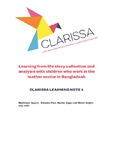| dc.contributor.author | Sayem, Mashrique | |
| dc.contributor.author | Paul, Sukanta | |
| dc.contributor.author | Apgar, Marina | |
| dc.contributor.author | Snijder, Mieke | |
| dc.coverage.spatial | Bangladesh | en |
| dc.date.accessioned | 2022-07-21T08:43:41Z | |
| dc.date.available | 2022-07-21T08:43:41Z | |
| dc.date.issued | 2022 | |
| dc.identifier.citation | Sayem, M.; Paul, S.; Apgar, M and Snijder, M. (2022) Learning from Life Story Collection and Analysis with Children who Work in the Leather Sector in Bangladesh, CLARISSA Learning Note 1, Brighton: Institute of Development Studies, DOI: 10.19088/CLARISSA.2022.006 | en |
| dc.identifier.uri | https://opendocs.ids.ac.uk/opendocs/handle/20.500.12413/17553 | |
| dc.description.abstract | CLARISSA (Child Labour: Action-Research-Innovation in South and South-eastern Asia) is a participatory evidence and innovation generating programme. We are generating evidence on the drivers of the worst forms of child labour (WFCL) and exploring how to address them through participatory Action Research (PAR) with children and other stakeholders in the leather supply chain in Dhaka, Bangladesh. Our main intervention modality is Systemic Action Research (SAR) (Burns, 2007), of which life story collection and analysis (LSC&A) is the first step in our participatory design that will inform child-led PAR groups which will become the engines of innovative responses to WFCL.
The LSC&A methodology is a storytelling and story listening methodology and was chosen because of the universal power of stories to make sense of complex realities and seek new futures. People across the world like to tell their stories; they like to feel listened to and they are interested in how their story connects and compares to others. By collecting and analysing stories from hundreds of children in WFCL we can visualise the bigger system that each individual story is connected to. We hypothesize that through engagement in the process of telling, listening, collecting, and analysing life stories, children engaged in harmful and hazardous work will use their understanding of systems dynamics to move into creating their own solutions to the drivers of WFCL.
In 2021 in Bangladesh, we collected 405 life stories from children living in Hazaribagh, Hemayetpur, Lalbagh, and Bhairab in Dhaka, with more than one hundred of these stories collected by children themselves. Following the story collection and transcription, children were supported by the CLARISSA implementation team to collectively analyse the stories through identifying critical ‘factors’ (events which have causes and consequences) and understanding how they causally relate to each other. The analysis of the 405 life stories resulted in the development of large system maps that illustrate all the causal dynamics that underpin lived experiences of WFCL. Based on the systemic analysis process the children identified themes of the PAR to be set up in their localities.
Our experience with the LSC&A methodology is the first in the context of children in WFCL. The methodology has been used in one other project in Bangladesh to date. We therefore intentionally aimed to learn from the implementation process and to evaluate if and how the telling of, listening to, collecting and analysing of life stories is empowering and in turn whether it leads to increased ownership of the problems which motivates collective action (Burns, 2021). In this learning note we share our methodological learning and reflect on operational implications for designing and facilitating an LSC&A process with children which we hope will support adaptation and use of the methodology by others working in participatory programming with children. | en |
| dc.description.sponsorship | Foreign, Commonwealth and Development Office (FCDO) | en |
| dc.language.iso | en | en |
| dc.publisher | Institute of Development Studies | en |
| dc.relation.ispartofseries | CLARISSA Learning Note;1 | |
| dc.rights.uri | http://creativecommons.org/licenses/by/4.0/ | en |
| dc.subject | Children and Youth | en |
| dc.subject | Work and Labour | en |
| dc.title | Learning from Life Story Collection and Analysis with Children who Work in the Leather Sector in Bangladesh | en |
| dc.type | Other | en |
| dc.rights.holder | © Institute of Development Studies 2022 | en |
| dc.identifier.doi | 10.19088/CLARISSA.2022.006 | |
| rioxxterms.funder | Default funder | en |
| rioxxterms.identifier.project | CLARISSA | en |
| rioxxterms.version | VoR | en |
| rioxxterms.versionofrecord | 10.19088/CLARISSA.2022.006 | en |
| rioxxterms.funder.project | e37f47ed-efba-4cc9-b41f-97dc8647b483 | en |


